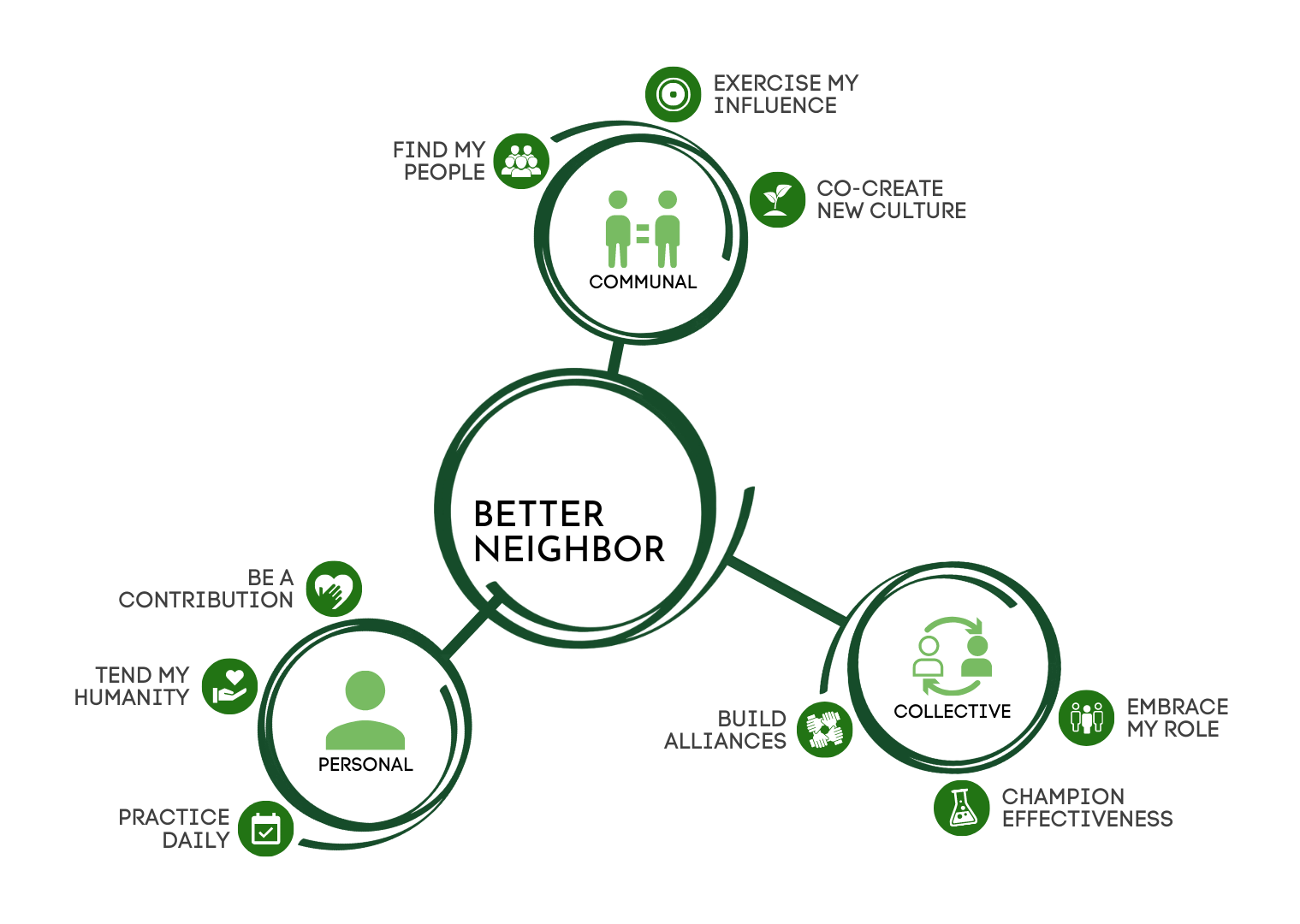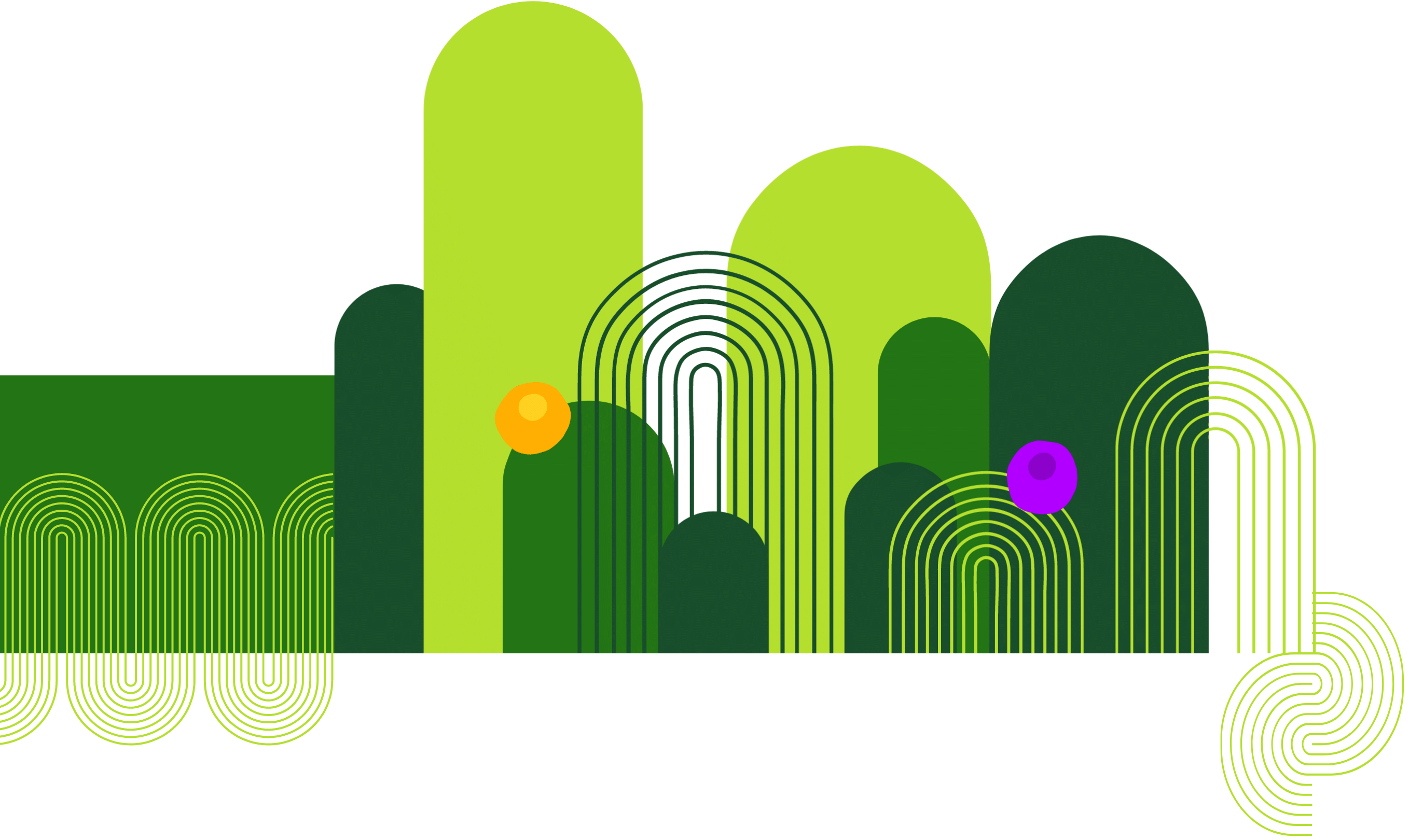Our Toybox
Becoming better neighbors
Naming practices are part of any culture.
We gift nicknames to people we love to signal our connection to each other. It’s no different in our liberation spaces. The moment someone says they are an “antiracist,” they’ve taken on a name and, in doing so, signaled who they belong with.
As our nation becomes increasingly polarized, we find ourselves searching for ways to declare our values with words that fuel connection rather than drive us further apart. If you are willing to consider that the future must include all of us and that no one is disposable, then this is for you.
Consisting of three core commitments and nine practices, our toybox is a way for us to play with the idea of becoming better neighbors to all living beings as a pathway to co-creating a more just world.





ready. set. go.
Use our toybox to assess your liberation journey

ready. set. go.
Use our toybox to assess your liberation journey
why "neighbor"
In his book, My Grandmother's Hands, Resmaa Menakem implores white-bodied people committed to ending racism to build a culture that can sustain our community. He writes

You can start by building a brief but compelling narrative that links the past, present, and future.
resmaa menakem

You can start by building a brief but compelling narrative that links the past, present, and future.
resmaa menakem
Indigenous people of our nation have long modeled a generations-deep way of truth-telling about our past and impact-imagining about our future.
As we look to draft a past, present, and future narrative, names like “antiracist” come into the frame for us to reconsider. Is it possible that by calling ourselves “antiracist,” we are creating a world that needs racism in order for our identity to remain intact?
Ouch.
We know that’s not what we meant to do.
All too often, despite our best efforts, we end up repeating the very things we are trying to stop.
If you are anything like us, you’ve long tired of the incessant shifting language of our movement spaces. It feels like we waste so much time coining new phrases only for them to be phased out months later.
This prompted us to consider:
- What was meaningful to our people before we became white?
- What is meaningful today as white people committed to ending racism?
- What will be meaningful to us once racism has ended?
These questions can help us filter various aspects of the culture we are co-creating.
And when it comes to naming, we think Mister Rogers was spot on:

Whether we're giving or receiving help, each one of us has something valuable to bring to this world. That's one of the things that connects us as neighbors - in our own way, each one of us is a giver and a receiver.
Fred rogers

Whether we're giving or receiving help, each one of us has something valuable to bring to this world. That's one of the things that connects us as neighbors - in our own way, each one of us is a giver and a receiver.
Fred rogers
Neighbors.
Not only does the idea of becoming better neighbors pass the test of time, spanning past, present, and future - it also offers an expansive view of who we are talking about.
Neighboring makes sense in PERSONAL, COMMUNAL, and COLLECTIVE realms. We are neighboring when we tend our humanity. We're neighboring when we gather with white people so we can co-create a white community no longer attached to racism. We're neighboring among change-makers from every community when we partner to end systems of oppression and co-create a world where all living beings - birds, fungi, rhinos, and humans alike - can flourish.
So how do we become better neighbors?

A greenhouse model thinks not about the outputs but about the conditions. People who work in a greenhouse focus on the conditions of the soil, the moisture in the air, and making sure there's enough sunlight. Over time, they know that if the conditions are right, you're going to get the fruit you need.
shawn ginwright

A greenhouse model thinks not about the outputs but about the conditions. People who work in a greenhouse focus on the conditions of the soil, the moisture in the air, and making sure there's enough sunlight. Over time, they know that if the conditions are right, you're going to get the fruit you need.
shawn ginwright
Environment and conditions. Picture ourselves as gardeners, cultivating a just future.
What does this bring up for you? Does it change how you think about our liberation spaces?
We know it’s changing some things for us...
Here are a few ways how...
DOMINATING PATTERNS we are trying to loosen from are alive in our movement. We are guilty of this, too, which is prompting adjustments like shared leadership, more time to cultivate relationships, inviting disagreement, developing awareness of dominating patterns, and more.
LIBERATION ABSENT OF HEALING is impotent. A healing-centered approach stops us from blaming someone else or believing we are powerless to stop racism. When we do this communally, we access the courage to become the kind of people we have always wanted to be.
AGREEMENTS are really common in liberation spaces. Once we admitted that “agreements” were often used to police each other, it was understandable why we were all stuck. All too often, when a liberation tool, term, or method isn't fruitful - we blame each other when what we really need to do is rethink.
CAPITALISM has a grip on our liberation movement. We see it in ourselves when we attach our value to a transaction, so we're experimenting with concepts rooted in gift economies. Other ways capitalism shows up are when we expect (or praise) perfection, performance, extroversion, intellectualism, etc.

learning to neighbor
Calathea plants are incredible, but they only thrive when they are grouped with other plants because they need the moisture that is shared among them. They are neighboring with each other, just like Mister Roger's said. Giving and receiving.
Becoming better neighbors is our how to our why. Our why is ending racism.
It’s why we live the way we live, work the way we work, and dream the dreams we do.
We believe in us. We love us. We’ll see you out there, neighbor.
no one gets here alone, and we are no different
The brilliant beings who have contributed to these ideas are Jomo Greenidge; Clarence and Eunice Covington; Jessie, Ron, and our neighbors on the 4th floor; no-name group; Mario Messina; Jackie and Shadow - the eagles of Big Bear Lake; Fred Rogers, Daniel Tiger, and everyone who contributed to cultivating a healing-centered place to tune in; Resmaa Menakem; Shawn Ginwright; Calathias and all of their neighbor plants; Sonya Renee Taylor; Lucius - cat of the neighborhood; Donna Maxey, founder of Race Talks; and countless more.


